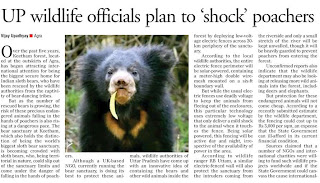In the great circulation race, newspapers distribute free sugar
Vijay Upadhyay
Agra. The prices of sugar may have been skyrocketing in the country over the past few months, but for the newspaper readers of Agra, sugar prices are something they hardly need to worry about.
The media competition induced by the entry of a new Hindi newspaper in Agra has brought a shower of freebies being offered by the two leading Hindi dailies of the town, including "free sugar", being distributed all over the town by these newspapers on the tunes of remix music with "no lucky draws" to participate.
This month, with the launch of the local edition of Dainik Hindustan in Agra, the readership battle between the two leading dailies of the town - Dainik Jagran and Amar Ujala - has suddenly grown stronger, having developed a third dimension in the form of the new entrant Hindustan that has been offering free copies of the newspaper to the readers of its two competitors.
Wary of the sudden warmed-up competition due to the entry of Hindustan in the media scene of Agra, both Dainik Jagran and Amar Ujala have embarked on an extensive publicity campaign to strengthen their hold on their existing readership base.
Incidentally, both the newspapers claim to have a hold on almost identical number of readers distributed between the two in the town.
Over the past month, both the newspapers have begun offering promotional schemes for their readers that contain household items like sugar and tea being distributed as freebies, the only condition - subscribe to the newspaper for at least a month without any gap.
And getting them free is not difficult just cut the coupons appearing in each issue and submit them to the collection vans to claim your free gift which could be anything from a one-kg sugar packet, a tea-pack, a duffel bag or a wrist watch.
While this may seem to be an unconventional way to publicise a newspaper, this ploy seems to be working with women being especially attracted to the "schemes" launched by both the newspapers and hardly do these newspapers arrive in the morning, the women of the house can be seen with a scissor in hand, cutting off the daily coupon from the paper.
The media competition induced by the entry of a new Hindi newspaper in Agra has brought a shower of freebies being offered by the two leading Hindi dailies of the town, including "free sugar", being distributed all over the town by these newspapers on the tunes of remix music with "no lucky draws" to participate.
This month, with the launch of the local edition of Dainik Hindustan in Agra, the readership battle between the two leading dailies of the town - Dainik Jagran and Amar Ujala - has suddenly grown stronger, having developed a third dimension in the form of the new entrant Hindustan that has been offering free copies of the newspaper to the readers of its two competitors.
Wary of the sudden warmed-up competition due to the entry of Hindustan in the media scene of Agra, both Dainik Jagran and Amar Ujala have embarked on an extensive publicity campaign to strengthen their hold on their existing readership base.
Incidentally, both the newspapers claim to have a hold on almost identical number of readers distributed between the two in the town.
Over the past month, both the newspapers have begun offering promotional schemes for their readers that contain household items like sugar and tea being distributed as freebies, the only condition - subscribe to the newspaper for at least a month without any gap.
And getting them free is not difficult just cut the coupons appearing in each issue and submit them to the collection vans to claim your free gift which could be anything from a one-kg sugar packet, a tea-pack, a duffel bag or a wrist watch.
While this may seem to be an unconventional way to publicise a newspaper, this ploy seems to be working with women being especially attracted to the "schemes" launched by both the newspapers and hardly do these newspapers arrive in the morning, the women of the house can be seen with a scissor in hand, cutting off the daily coupon from the paper.


Comments